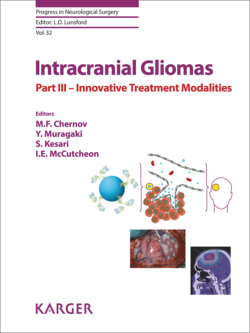Intracranial Gliomas Part III - Innovative Treatment Modalities

Реклама. ООО «ЛитРес», ИНН: 7719571260.
Оглавление
Группа авторов. Intracranial Gliomas Part III - Innovative Treatment Modalities
Progress in Neurological Surgery
Intracranial Gliomas. Part III – Innovative Treatment Modalities
Contents
Series Editor’s Note
Preface
Photodynamic Therapy of Malignant Gliomas
Abstract
Introduction
Basic Principles of Photodynamic Therapy
Photosensitizer
Light
Mechanism of Photodynamic Therapy and the Role of Oxygen
Current Status of Photodynamic Therapy for Malignant Gliomas
Controlled Studies
Personal Experience with Photodynamic Therapy of Gliomas
Stereotactic Interstitial Photodynamic Therapy
Intraoperative Photodynamic Therapy
Safety of Photodynamic Therapy
Conclusion
Acknowledgments
Disclosure Statement
References
Laser-Induced Interstitial Thermotherapy of Gliomas
Abstract
Introduction
Basic Principles
Neurobiological Effects
Posttreatment MRI
Role of Intraoperative MRI during LITT
Main Technological Systems for LITT
NeuroBlate® System
Visualase® System
Systematic Review of Clinical Results of LITT for Intracranial Gliomas
Conclusions
Disclosure Statement
References
Stereotactic Cryodestruction of Gliomas
Abstract
Introduction
Rationale for Stereotactic Cryodestruction of Intracranial Gliomas
Personal Experience with Stereotactic Cryodestruction of Intracranial Gliomas
Device for Cryosurgery
Treatment Planning and Surgical Technique
Postoperative Management
Perioperative Complications
Imaging Changes
Survival Analysis
Advantages and Limitations of Stereotactic Cryodestruction of Gliomas
Conclusion
Disclosure Statement
References
High-Intensity Focused Ultrasound Ablation Therapy of Gliomas
Abstract
Introduction
Ultrasound
Thermal Effects
Cavitation
Ultrasound Systems for Clinical Treatments
Magnetic Resonance Thermometry
Clinical Experience with HIFU Ablative Therapy
Conclusion
Disclosure Statement
References
Boron Neutron Capture Therapy of Malignant Gliomas
Abstract
Introduction
Basic Principles of BNCT
Selective Accumulation of the Boron-Containing Compound in the Tumor
Role of Positron Emission Tomography
Clinical Results of BNCT of Malignant Gliomas
Recurrent Malignant Gliomas
Newly Diagnosed Malignant Gliomas
Recent Developments: From Nuclear Reactors to Accelerators
Conclusion
Disclosure Statement
References
Proton and Carbon Ion Therapy of Intracranial Gliomas
Abstract
Introduction
Standard Fractionated Radiotherapy of Intracranial Gliomas
Rationale for Particle Therapy of Gliomas
Comparison of Proton and Carbon Ion Radiotherapy
Clinical Results of Particle Therapy for Intracranial Gliomas. Low-Grade Gliomas
High-Grade Gliomas
Recurrent Gliomas
Limitations of Current Clinical Knowledge
Conclusion
Disclosure Statement
References
Novel and Prospective Molecular Targets for Therapy of Intracranial Gliomas
Abstract
Introduction
Inhibitors of Growth Factor Receptors
EGFR
PDGFR
Inhibitors of Intracellular Signaling Pathways
PI3K/AKT/mTOR-Targeted Therapies
Ras/Raf/MEK-Targeted Therapies
p53- and Rb-Targeted Therapies
Alterations in Tumor Metabolism
IDH1/IDH2
Anti-Invasion Strategies
Other Molecular Targets and Agents. PARP Inhibitors
Histone Deacetylase Inhibitors
MicroRNA
Cannabinoids
Summary and Conclusion
Disclosure Statement
References
Cytokine Therapy of Gliomas
Abstract
Introduction
Cytokines and Cytokine Therapies
Interleukin-4
Interleukin-13
Transforming Growth Factor-β
Interleukin-2
Granulocyte-Macrophage Colony-Stimulating Factor
Interferon-Based Therapies
Interferon-α
Interferon-β
Interferon-γ
Conclusion
Disclosure Statement
References
Cell-Based Immunotherapy of Gliomas
Abstract
Introduction
Immunotherapy for Gliomas
Tumor-Induced Immunosuppression
Immunotargeting the CNS
Passive Cellular Immunotherapy with Adoptive Cell Transfer
Tumor-Infiltrating Lymphocytes
Lymphokine-Activated Killer Cells
γδ T Cells
Allogeneic Mixed-Lymphocyte-Reactive T Cells
Engineered Immunity with Genetically Modified T Cells
Chimeric Antigen Receptors
Active Cellular Immunotherapy with Dendritic Cell-Based Vaccines
Patient-Specific Multi-Antigen Vaccine Therapy
Specific Targets
Conclusions
Disclosure Statement
References
Vaccine Therapy of High-Grade Gliomas
Abstract
Introduction
Vaccine Therapies for High-Grade Gliomas
Autologous Formalin-Fixed Tumor Vaccine
Role of Vaccines in Combination Therapy of High-Grade Gliomas
Conclusion
Disclosure Statement
References
Gene Therapy and Virotherapy of Gliomas
Abstract
Introduction
Common Delivery Vehicles for Gene Therapy. Virus-Based Gene(s) Delivery
Non-Viral Approaches of Gene(s) Delivery
Common Viruses for Oncolytic Virotherapy of Gliomas. Herpes Simplex Virus Type 1
Adenoviruses
Reoviruses
Measles Virus
Poliovirus
Other Viruses
Therapeutic Genes for Treatment of Gliomas. Conditional Cytotoxic Genes
Targeted Toxins
Transgenes for Targeting Specific Hallmarks of Glioma
Immunomodulatory Gene Therapy
Combinatorial Therapy: Oncolytic Viruses Carrying Therapeutic Gene(s)
Potential Advantages of Gene Therapy and Virotherapy
Conclusion
Acknowledgment
Disclosure Statement
References
Stem Cell Therapy of Gliomas
Abstract
Introduction
Definition of Stem Cells
Classification of Stem Cells
Clinical Applications of Stem Cells: Overview
Stem Cells in Brain Tumor Therapy: Types, History, and Rationale
Neural Stem Cells
Mesenchymal Stem Cells
Alternative Strategies
Biological Basis for Stem Cell Homing to Gliomas
Modifications to Increase Stem Cell Homing
Types of Therapeutic Cargo
Secreted Proteins
Antiangiogenic Factors
Prodrug-Converting Enzymes
Replication-Competent Oncolytic Viruses
Antibodies
Nanoparticles
Administration Routes of Stem Cell Therapy in Clinical Applications
Clinical Trials
Conclusions
Acknowledgments
Disclosure Statement
References
Convection-Enhanced Delivery for Management of Malignant Gliomas
Abstract
Introduction
Convection-Enhanced Delivery
Basic Principles
Practical Challenges
The PRECISE Trial
Conclusion
Disclosure Statement
References
Targeted Local Therapy for Management of Intracranial High-Grade Gliomas
Abstract
Introduction
Intratumoral Injections and Infusions
Convection-Enhanced Delivery
Nanocarriers
Liposomes
Nanoparticles
Dendrimers
Gels
Microchips
Polymers
Conclusion
Disclosure Statement
References
Extracellular Vesicles as a Platform for Glioma Therapeutic Development
Abstract
Introduction
Definitions
Exosomes
Microvesicles
Methods of EV Purification and Characterization
EV as a Basis for Glioma Therapy
Inhibition of EV Production and Uptake
EV-Based Immunotherapy
EV for Therapeutic Delivery
Conclusion
Disclosure Statement
References
Alternating Electric Fields Therapy for Malignant Gliomas: From Bench Observation to Clinical Reality
Abstract
Introduction
Basic Mechanisms of TTFields Therapy
Induction of a Mechanical Force on Protein Dipoles
Alterations of Mitotic Function during Cytokinesis
Molecular Targets of TTFields
Apoptosis and Immunogenicity
Distribution of TTFields within the Brain
Clinical Results of TTFields Therapy of Intracranial Gliomas
Conclusion
Disclosure Statement
References
Perspectives of Nanotechnology in the Management of Gliomas
Abstract
Introduction
Molecular Imaging
Optical Capabilities of Nanoparticles
Applications of the Nanoparticle-Based Imaging
Nanoparticles for MRI
Instrumentation for Fluorescence Nanoscopy
Toward Clinical Applications
Tumor Imaging with Near-Infrared Emitting Nanoparticles
Nanomaterials for Drug Delivery
Applications of Hybrid Nanomaterials
Current Limitations and Future Perspectives
Biological Considerations
Technical Considerations
Need for Interdisciplinary Teamwork
Conclusion
Disclosure Statement
Acknowledgments
References
Author Index
Subject Index
Отрывок из книги
Vol. 30
Intracranial Gliomas
.....
Prabhu, S.S. (Houston, TX)
Targeted Local Therapy for Management of Intracranial High-Grade Gliomas
.....